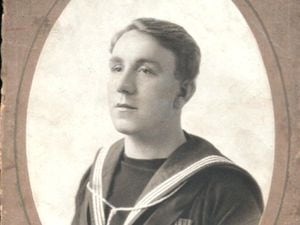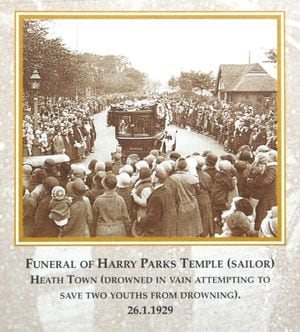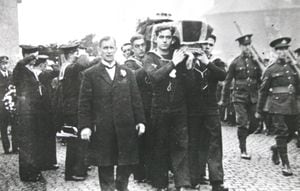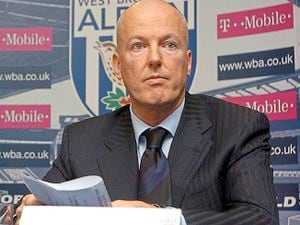Hero sailor who died trying to save two boys from icy lake may finally get a headstone after 94 years
It was a remarkable sight. The crush outside the church was so great that 40ft of heavy railings came crashing to the ground, taking the gate pillar with it.

Five thousand people packed the cemetery to see Harry Park Temple’s body interned. The crowds were so big that some people required medical treatment.
And the vicar said he hoped that a lasting memorial would be built in Wolverhampton, so that Harry's deeds would never be forgotten.

It was the sort of scene you might have expected for the funeral of a member of the royal family, or a war hero killed on the battlefield. A wealthy philanthropist maybe, or a benevolent industrialist much loved by his employees.
Harry was none of these. A 27-year-old sailor, with 10 year's service, he was on shore leave staying with his mother in Willenhall Road, Wolverhampton, when he gave his life trying to save the two teenage boys who fell into an icy lake near their homes.
But while Harry's death may have brought a town to standstill, and the vicar spoke of the need for a permanent memorial, his grave is not even marked with a headstone.
As the crowds went home, and people returned to the drudgery of their daily lives, his act of selflessness also passed into history. His heroism is commemorated by a stained glass window in Chatham, Kent, and there is a plaque at his old school in Wolverhampton. But in the churchyard where he is buried – nothing.

Now, more than 94 years since his death, that glaring omission will belatedly be made good.
Josie Low, whose grandmother was a cousin of Harry, has finally secured a headstone for her relative, Thanks to the help of Wolverhampton-based Wilkinson stonemasons, this will be installed at his grave in Bilston Cemetery ready for a memorial service planned for next year.
"We knew about Harry, our grandmother Gertrude Greene told us about him when we were children, but we didn't talk about it that much at the time," says Mrs Low, who grew up in Wednesfield, but now lives near Welshpool.
"Growing up you are too busy living your life to think about these things, and then when you are older you curse yourself for not asking questions."
Some years later, when she became interested in her family history, she started researching his story.
"We were mortified to see that his grave had no headstone, and that he spent 94 years lain in an unmarked grave," she says.
Mrs Low approached a friend who worked for Wilkinson, and was delighted when the company agreed to provide the headstone free of charge.
"Chris and Nikki Wilkinson are very keen on local history, and they offered to provide the stone," says Mrs Low, adding that she has now secured to permit to install the stone at his grave.
According to the Express & Star, 16-year-old Joseph Elmore, and his 15-year-old friend Harold Heath, had spent the afternoon of January 20, 1929, with other lads sliding around on the ice-covered Cinder Pool off Willenhall Road.
The pool, near the British Oak pub in the East Park area of town, was what locals used to call a 'swag', a huge hollow in the pit mounds, 20ft deep with water. At about 5.30pm the ice suddenly gave way about eight feet from the edge of the pool, and the boys fell into the freezing water.
"Immediately, an alarm was raised," the Express & Star reported, "and an urgent message for help reached a group of men playing football on a stretch of waste and not far from the pool.
"There was a rush to the spot, and the young sailor Temple, who outstripped his fellows, threw off first his cap and then his jumper, and began a perilous crawl along the ice, one-and-a-half inches thick, towards the hole where Elmore was struggling to maintain some sort of grip. Heath had already disappeared."
Thomas Whittingham, who had been playing football with Harry, said they were part of a group of about a dozen friends who were making their way home.
He told the Express & Star: "When Temple crawled across the ice to get hold of Elmore, it seemed to me as if the boy had got hold of Temple's legs.
"They were struggling to break the ice, and both seemed to disappear all of a sudden."
He said Harry's last words were: "I have finished."
Harry who lived with his mother at Lower Walsall Street, Horseley Field, had only been home four days. Also with him and Thomas were friends Harry Davies, Harry Walters, George Deakin and Jack O'Connor.
"We all knew Temple," said Harry Davies, who lived at the Red Lion Hotel, Lower Horseley Field.
"He was a good swimmer, and the best chap in the world. He was absolutely a hero, there is no doubt about it."Harry Walters, of Horseley Field, said by the time he arrived, Temple was already on the ice. Whittingham jumped into the water, so he went to get a rope.
"It was all over in about two minutes."
His funeral was held on January 28, with a memorial service at St Matthew's Church, Horseley Field, followed by his internment at Bilston Cemetery.
"So dense was the crowd and so keen the curiosity that a number of women mounted the railings on the south side of the churchyard, either to escape the pressure of the crowd, or to obtain a better view," the Express & Star reported.
"About 40 yards of heavy iron railings collapsed and fell, fortunately inward to the churchyard. With them was carried the gate pillar and its coping, a mass of stone weighing several hundredweight.
"Had the stone fallen outwards into the dense crowd, many casualties must have occurred."
Emily Whitehouse, 30, of Willenhall Road, was taken to hospital after falling masonry broke her ankle. Mrs Hodgkiss, of Upper Zoar Street, received bruises and a cut to the mouth, while a young girl escaped injury after being trapped beneath the railings.
The Special Constabulary Band stood played Handel's Dead March outside the church, with members of the South Staffordshire Regiment also present in uniform.
Six naval ratings from HMS Pembroke, based at Chatham Royal Naval Barracks, carried Harry's plain oak coffin into the church, which was covered with a Union Jack, Harry's cap collar, and his black silk scarf. His mother wept as she and her other son led the chief mourners behind the naval bearers. Two ships' buglers fell in behind.
Neighbours of Harry sent a floral representation of a ship, which was filled with daffodils which 'rocked in the in the glinting January sunshine, amid a wealth of other beautiful flowers sent by relatives and sympathisers from far and wide.'
The service was led by the Reverend Thomas Stanton, whose voice trembled as he paid tribute to the young sailor.
"Our dear hero, Harry Park Temple, did wonderful service," he told the congregation.
"But Temple has not died in war. He has died 'fast by his native shore', and we can thank this lad of Wolverhampton, who, to the death, proved himself a sailor and a man, with our great heroes who made the supreme sacrifice.
"Let us hope his example will be taken that others who will learn that the art of life is to sacrifice something for others."
The parents of Harold Heath, one of the boys Harry had tried to save, sent a wreath to the funeral bearing the words: "In remembrance of a brave son who gave his life for others."
Five thousand mourners crowded into Bilston Cemetery to watch six of Harry's shipmates carry his coffin to his grave, close to the last window of the little chapel.
The funerals of the two boys, Harold Heath and Joseph Elmore, were held at Heath Town.
Joseph, an orphan, had lived in Coventry Street, and his parents were also buried in the same cemetery. Stowheath Villa FC sent a wreath bound with a broad ribbon of the team's colours.
For Harold, who lived in Park Terrace, Willenhall Road, a choral was held at Heath Town Church, and a wreath was sent from the junior football team at Courtaulds where he worked.
As a child, Harry Park Temple had attended Willenhall Road Boys’ School, before leaving to work as a fitter’s mate at Lewis’s in Horseley Fields. He joined the Royal Navy when he turned 17, where he served 10 years. He was an Able Seaman aboard HMS Repulse, and had three medals.
He was on a fortnight's leave from Chatham Barracks in Kent, and was due to return the following week when he was due to head for China, where he would have spent the next two-and-a-half years.
Harry was described as having been a good all-round athlete and a good swimmer. He played for the HMS Wanderer football team, which had won a trophy in 1925. His father, who had served in the Army Service Corps, had died about seven years earlier.
A neighbour said: "Harry was a good lad to his mother, a better son you could never wish to see."
His bravery is also commemorated in the Carnegie's Hero Fund Trust's roll of honour at the Andrew Carnegie Birthplace Museum in Dunfermline.
In a 1997 letter to the Express & Star, reader Howard Seaman recalled how he was among the youngsters sliding on the ice at the time of the tragedy.
"We had been sliding on the ice of the Cinder Pool," he wrote. "We’d had a very cold spell and the ice had formed quite thick on the pool. It was quite foggy at the time and after awhile we came away.
"About an hour later, someone came and said that Harry Temple, who was home on leave from the Royal Navy, was under the ice on the pool.
"He lived in a house on the other side of the road about 150 yards away. We heard later that he had been trying to save two friends of his, who had gone through the ice."
Mrs Low plans to hold the memorial service on June 6 next year – which is also the anniversary of D-Day. A fitting time to honour another hero of the West Midlands.





